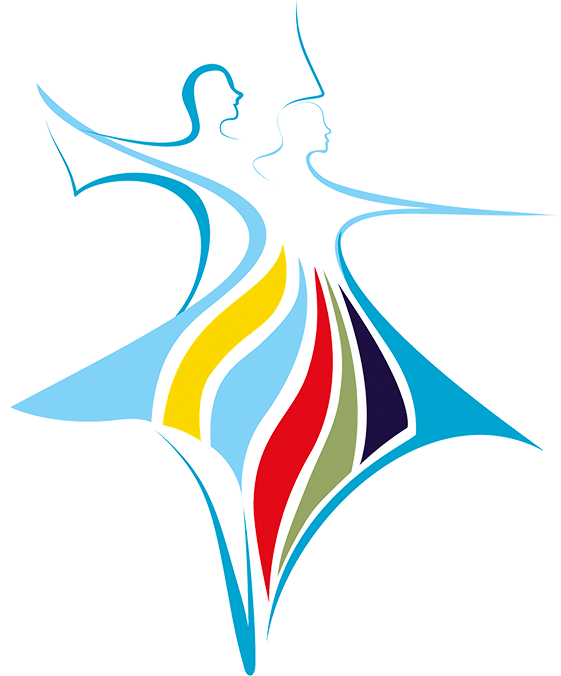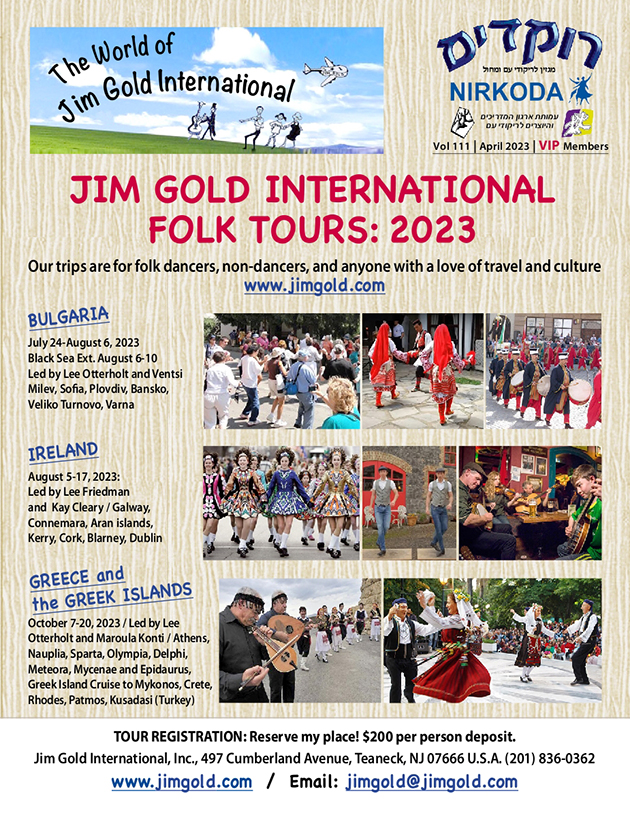- Home
- Rokdim Nirkoda 111
- We Need a “Fallow Year”About “Folk Dances”, “Recreational Dances” and “Temporal Dances”
We Need a “Fallow Year”About “Folk Dances”, “Recreational Dances” and “Temporal Dances”
About "Folk Dances", “Recreational Dances" and "Temporal Dances”
- Translation: Dena Matmon
Preface
This article attempts to look at our “folk dance” scene as an ongoing process rather than a single point in time. It is intended for those who view folk dance as Israeli culture whose existence in the future depends on our conduct in the past, present and future.
It indicates the process we are in and where it will lead us, if we do not try to change direction. It is aimed at instructors for whom “folk dance” is not only a livelihood, but also a way of life and who look at the way we construct this scene from a broad perspective, with the goal of cultivating a unique Israeli culture.
This article has no intention of harming the livelihood of any of those involved in the field – absolutely not!
Today there are about 30-40 “real” folk dances; (there used to be many more). They are taught in some of the beginner folk dance sessions and are danced at “special dance sessions” and in groups arranged for festive occasions. Unfortunately, they are decreasing in number… The proliferation of “recreational dances” pushes aside the dwindling “folk dances”. Now, a new style, “temporal dances” (dances done for only a short period of time), has come into being, pushing aside the many “recreational dances” that were regularly danced at the weekly dance sessions.
We are all familiar with the parable about a man who falls from a tower, and in response to a question about his conditions, he replies: “So far, so good.” (At this point, he hasn’t reached the bottom yet.)
The frog says the same thing when it is in a pot of water on the fire that hasn’t yet reached the boiling point…
With us, the process has been going on for years and is only intensifying. Like the examples above, this isn’t a black and white situation. The changes are part of a “process” and can’t be identified at any given point in time, but only by looking at today’s reality from the perspective of decades back and given that we have a desire to dance together at every opportunity.
The Essence And Secret Of The Magic Of Folk Dance
Folk dance is for everyone. You don’t need to be a professional dancer to participate. Also, there is no need to practice for many hours so that your movements will be aesthetic and “professional”. The magic of folk dancing, the enjoyment and satisfaction, come from moving together. When many people perform many movements together, whether simple or complex, to the sound of different varieties of music – we live through an aesthetic experience, even if we’re not professional dancers and the movements (of most of us) aren’t exactly aesthetic-professional.
We generally dance in closed (indoor) halls. Note, if we dance outside there are generally onlookers who stand around for hours and enjoy watching the dancers. They don’t see beautiful costumes, they don’t see professional movement, it is just pleasurable to the eye. For them, the “wonder” and the enjoyment come from the fact that plain ordinary people, people like them, know so many movements and move together to the sounds of different songs.
So, these dances are suitable for everyone. You don’t need to be a professional dancer. It’s necessary to practice learning the steps and movements that are adapted to the music. Everyone should know the steps, movements and the directions for all to dance together. Our enjoyment and satisfaction stem from the fact that we dance together. Few (if any) will dance alone in their living rooms at home for an entire evening… (even dancing on Zoom during the Corona years gave us a feeling of “dancing together” with other people watching the same Zoom).
There are other “benefits” that we receive from this culture: it sharpens our memory; we hear Israeli songs; have social interactions; engage in a sport, develop coordination; find a partner; and much more. All of these are the result of our ability to continue folk dancing as explained above.
In order to enjoy the dances, we need to know the steps. We can’t dance an entire evening by imitating the instructor or other dancers.
“Copy Paste” As A Method, Instead Of Through Instruction
The proliferation of new dances has a direct impact on the quality of learning and the method of teaching (both for the instructor and the learner).
In general, the instruction of dances today is not very thorough. Instruction is very fast and accompanied by words such as, “we’re almost finished” (as if to ease the suffering of the learner). The dancers are less patient and tend to dance by the “copy-paste” method as most convenient for them (instead of learning in an organized manner) saying: “In any case, the dance won’t last for very long, so why invest the time to learn it”?
The process is much more difficult in dance sessions for older people and for youngsters. In those groups, an entire method has developed through imitating (copying) the instructor, that is, there’s no need to learn. The dancers, whether senior or young, don’t need to learn the specific order of the movement. They just need to follow the instructor through the “follow me” method and then, later on, if there’s no instructor, they can’t dance the dance.
The quality of instruction also has an additional manifestation: the dances all resemble one another. When there’s a special step, a little different, that “sits” differently on the rhythm, “acts” differently than what we’re used to (thus creating a difference, some interest, something special) – the dancers very quickly give up on this special step and “upgrade” it to a simpler step (see the terms for “Yemenite step”, “Mayim step”) that they’re used to doing from other dances. Thus, the innovation doesn’t become accepted. (See the classic example in part four of “Na’aleh, Na’aleh”.)
Dance Leaders or Dance Instructors
In the last 15 years, many dancers have acquired “instructor” certificates. In my opinion, it’s a good idea to have as many people as possible take this course, even if they don’t engage in dance instruction. The very fact of exposure to this content enriches the dancer.
The course work for receiving the certificate has been shortened from two years to one year. (The “need” is to accomplish a lot and do it quickly.) The knowledge of most of the students in heritage/tradition, in history, in original/early and “middle of the road” (i.e., not the most current) dances, is definitely not sufficient. They joined the “Dance Leaders (Dance Instructors?) Course” because they love the dances (and perhaps because they think it’s an “easy profession”), after they’ve been exposed to mainly large quantities of new dances that don’t last long.
At the end of the course, even with insufficient experience, they open their own “chug” – dance session (today called a “Harkada”); they will of necessity teach what they dance and know from the groups in which they participate. They will quickly give up on the basics (those 30-40) folk dances mentioned above, and which are slowly decreasing in number). Moreover, they feel that in order to appeal to more skilled and veteran dancers, they must quickly teach, and perhaps before everyone else, a dance that they learned only yesterday at a main dance session.
I was like that at the beginning of the ‘80s, when I came to the city from the kibbutz. I remember that I attended many groups of my teacher and mentor, Mishael Barzilay z”l. I once asked him: “Don’t you get tired of continually teaching dances like, “Lo Ahavti Dai”, “Hora Hadera” and others like that?
And he replied: “Just the opposite. I enjoy teaching people who know nothing and instilling in them the love of folk dancing.”
From his reply, I understood then, and today I understand even more, that I don’t teach “dances”. I teach people “to dance”. I teach the basic steps, the basic patterns, rhythms, and coordination, but mainly, I teach them the enjoyment of “moving together”.
How Many “Folk Dances” Are There?
I ask this question over and over. Of course, there is no “correct” answer because new dances are being choreographed at an increasing pace and in great quantity. How many of them are actually danced? What’s for sure is that, the more new dances are choreographed, the fewer “folk dances” there are and today there are also fewer “recreational dances” because they are pushed aside in favor of the “temporal dances”.
In order to know the dances, so that they remain with us for a long time to come, we should dance them repeatedly – at first, once or twice a week for several months and then every few weeks. The fact is that those dances that were danced in the ‘80s and ‘90s, and indeed, we danced them at every session, are for us, like riding a bicycle. We can dance them today without effort and without “copying”. But what happens when there are more and more new dances, as beautiful and interesting as the they may be?
The more time we spend learning new dances, the less time we have to dance and to remember the dances that we learned in the last weeks and months, and much less time to go over the dances we knew from the past, from years ago. Thus, these folk dances and “recreational dances”, that we knew from 10 -20 years ago and longer, disappear.
An instructor (dance leader = DJ these days) who wants to play the music for several dances that we knew from 30 and 40 years ago, will always choose those that he thinks everyone knows. In this way, the list of recreational dances from the past gets shorter and shorter. The more dances there are on paper, the fewer dances we can dance together, at any time, without someone to copy from.
I will even dare to say that most of the leading choreographers in the field are aware of the situation and understand that this is a “slippery slope”, but they have no choice. They continue to create more dances in order to “remain in the circle”, to be relevant. They do everything to lead the “race” and especially to be invited to instruct dance groups abroad.
The inevitable result is a large public of dancers (that is growing all the time) who execute the steps in the “copy-paste” method, even with dances that have been done in the groups for two or three months and other dances that were popular 10 or 15 years ago. And meanwhile, the older dances, i.e., 20, 30 and 40 years old – are being forgotten.
Those who dance in groups or in sessions aren’t obligated to learn the new dances. No one demands that the instructor teach a dance that hasn’t been seen anywhere. They do demand to dance something that they had learned yesterday at a dance session in which they participated with a neighboring instructor. If the “neighbor” didn’t teach the dance, there would be no such demand…
Social Media
As in every walk of life, social networks, (especially Facebook) permit manipulation, spread good things and some that are less good. They create social trends. The manner of dissemination of dances today is convenient and available to everyone. No one cares if credit is given (by law) and in particular no one cares about the ethical-moral side of things (name of the original song, the composer, the poet/lyricist, the performer). Even the quality of the video and the possibility of learning the steps through the recording aren’t particularly important. A few clicks of a button and everyone can watch and “express an opinion”.
And then come the complimentary comments: “What a beautiful dance”, “wonderful”, “fantastic”, “good luck”, and on and on. Did all those commenting really dance the dance? Did they feel the dance in their feet? Did they dance it with a large crowd of people? Do they really believe what they said? Generally, the answer is “no”. They’ve heard a nice song, saw a friend who choreographed the steps – and they give positive comments. Why not?
I have been dancing for more than 50 years and I don’t think that I’m able to express a real opinion about a dance before I’ve danced it several times.
What Is the Motivation For Choreographing The Dances?
The “essence”, which was described above – the desire to see a large crowd of people who are not professionals – dancing together – was the primary motivation, the main and most important reason for all the dances choreographed during the first 20-30 years – the early years of the State [Israel].
What has been the motivation for the composition of new dances in the last 10-20 years? What pushes a growing public of dancers and instructors to choreograph (the word “create” isn’t suitable. I would write “produce”) more “dances”, when most of them are just a collection of repetitive steps, following alternating songs and melodies and none of them have any new steps?
I will admit that there are several new dances that stick with the rhythm, are pleasant to dance and are choreographed to popular songs heard on the radio, pleasant dances… So what? Do they contribute to the “togetherness” that I explained above?
There are those dances (few) that have a new “element”, some new movement, a connection to the music that’s slightly different from previous dances, a relationship to the words in an interesting way, that somehow relates to our roots and heritage. In short – some kind of new choreography.
Here are some possible motivations for the mass production of dances (again, I emphasize: that is a generalization):
- The need to produce an artistic dance choreography to some song regardless of whether it is danced (there are less than a handful of such choreographers).
- The feeling that the song that you “caught” (from the organization’s site) is the hit that will lead people to dance your dance.
- An inner, subjective feeling that you have a new “gospel” with the steps you have put together to the popular music.
- A desire to be recognized in the field – personal advertising. To be given the title of “creator / choreographer”.
- Trips abroad (with the necessity to bring new dances to the dance camps).
- Positive comments on social media.
- To be invited to teach at events and dance sessions in Israel and then abroad.
- To remain relevant. Not to be forgotten.
Solutions?
There is no magic solution. The way to a solution is, first of all, recognizing that there is a problem and that we very much wish to find a solution. And if you have read this article thus far – then maybe I’ve also succeeded in convincing you.
We have a data bank of hundreds and even thousands of dances that can be taught as “new dances” even if they were choreographed 5 or 10 years ago or more. These are dances to good and beautiful songs that we didn’t have time to teach when they “came into the world”.
The leading choreographers each have a supply of dozens and hundreds of dances that they can teach abroad as “new” dances, even if they were choreographed years ago…
I am a great believer in folk dancing as a unifying social activity. We need to be clever, to walk together, to work in unison. The competition between us can be in how we present the dances, the mix of dances, creating an atmosphere and not a feeling of “whoever is the fastest to teach the dance that was created an hour ago”.
The correction is possible only if we all agree to it, especially the leading choreographers.









Comments
התראות